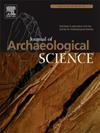Lipidomics of naturally preserved brains from the First Baptist Church of Philadelphia cemetery
IF 2.6
1区 地球科学
Q1 ANTHROPOLOGY
引用次数: 0
Abstract
The preservation of human soft tissue in archaeological contexts is rare, and the natural preservation of brain tissue is even more uncommon. This study examines the lipidomic profiles of naturally preserved brains recovered from the First Baptist Church of Philadelphia (FBCP) cemetery, dating from the 18th and 19th centuries. Using high-resolution mass spectrometry, we successfully extracted and identified sphingomyelin and phosphatidylcholine species from naturally preserved brain tissues. These findings demonstrate that lipidomic analysis can be applied to archaeological brain tissues, providing insights into neurological health and disease in past populations. The integration of advanced molecular techniques in bioarchaeological research holds significant potential for future studies of ancient diseases, preservation processes and forensic applications.
费城第一浸信会墓地自然保存的大脑的脂质组学
人类软组织在考古背景下的保存是罕见的,而脑组织的自然保存更是罕见。这项研究调查了从费城第一浸信会(FBCP)墓地中恢复的自然保存的大脑的脂质组学特征,这些大脑可以追溯到18世纪和19世纪。利用高分辨率质谱技术,我们成功地从自然保存的脑组织中提取并鉴定了鞘磷脂和磷脂酰胆碱。这些发现表明,脂质组学分析可以应用于考古脑组织,为过去人群的神经健康和疾病提供见解。生物考古研究中先进分子技术的整合对未来研究古代疾病、保存过程和法医应用具有重大潜力。
本文章由计算机程序翻译,如有差异,请以英文原文为准。
求助全文
约1分钟内获得全文
求助全文
来源期刊

Journal of Archaeological Science
地学-地球科学综合
CiteScore
6.10
自引率
7.10%
发文量
112
审稿时长
49 days
期刊介绍:
The Journal of Archaeological Science is aimed at archaeologists and scientists with particular interests in advancing the development and application of scientific techniques and methodologies to all areas of archaeology. This established monthly journal publishes focus articles, original research papers and major review articles, of wide archaeological significance. The journal provides an international forum for archaeologists and scientists from widely different scientific backgrounds who share a common interest in developing and applying scientific methods to inform major debates through improving the quality and reliability of scientific information derived from archaeological research.
 求助内容:
求助内容: 应助结果提醒方式:
应助结果提醒方式:


